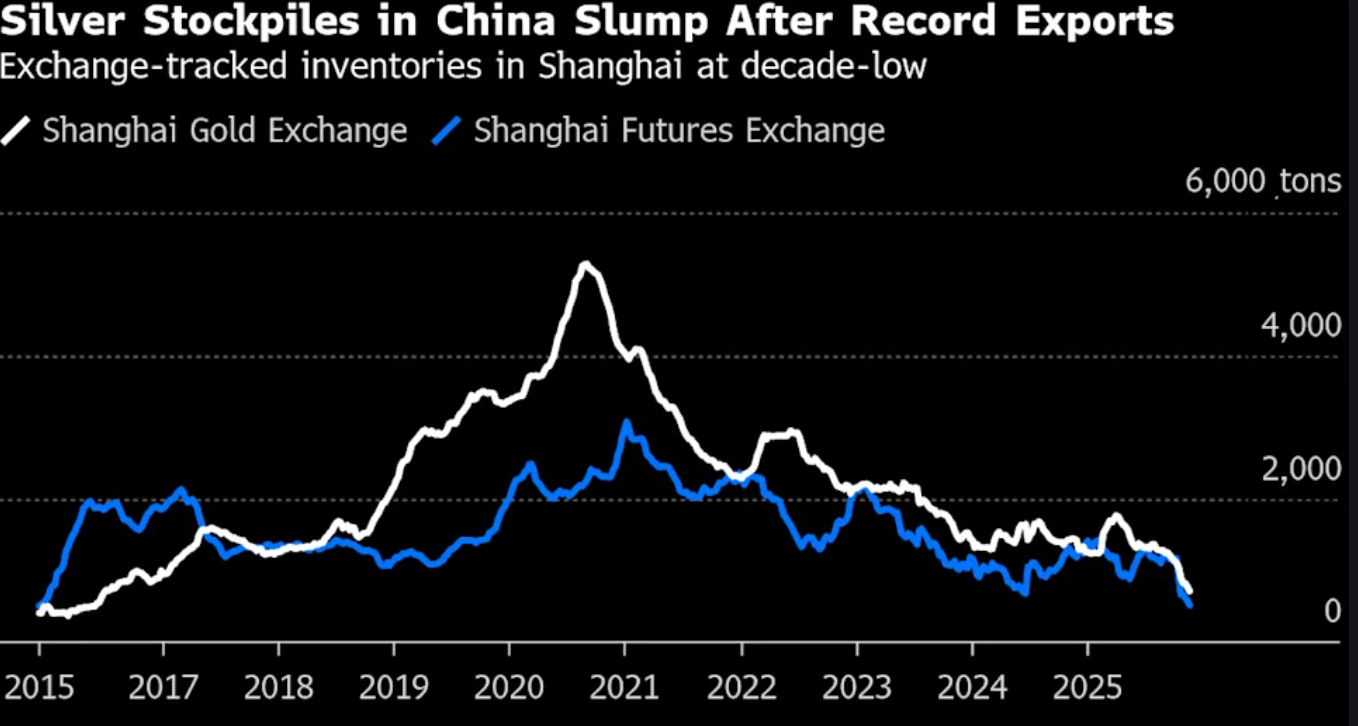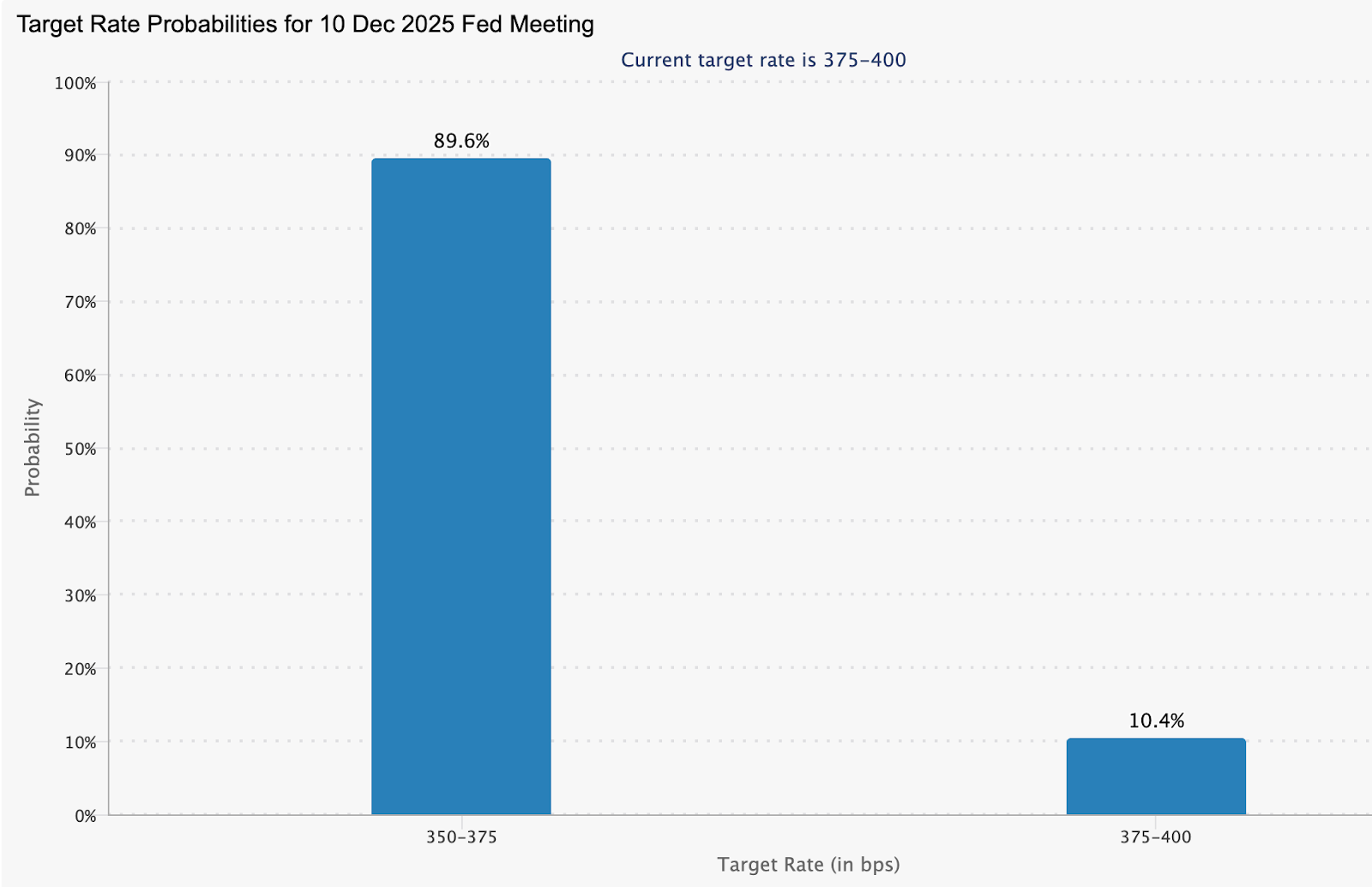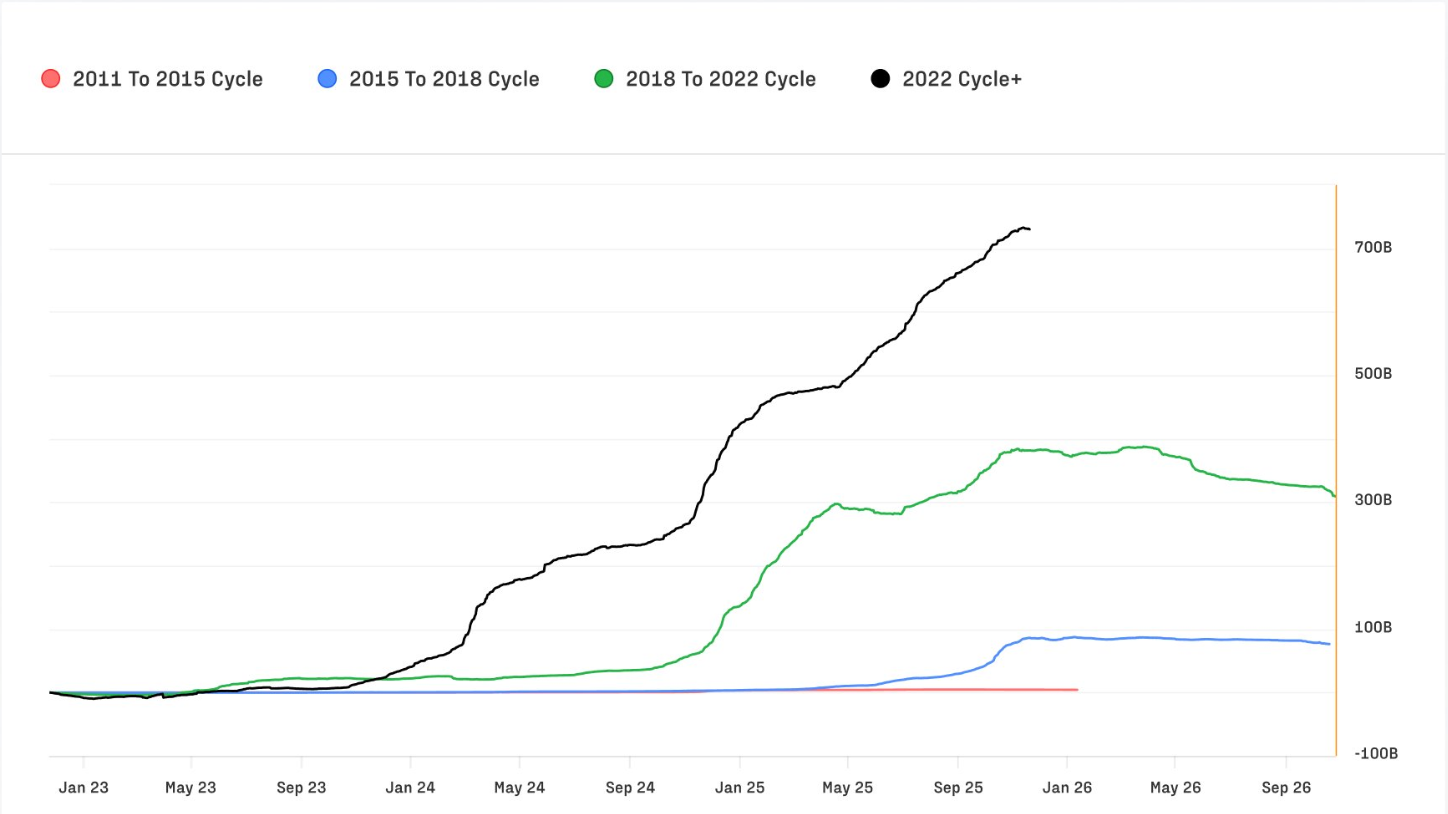结果
.png)
Markets react after Fed cut as volatility surges
The Federal Reserve cut interest rates for the third time this year, lowering the federal funds rate to 3.5%–3.75% and signalling a slower, more uncertain path ahead. Markets responded in sharply contrasting ways. Bitcoin plunged more than $2,000 in 24 hours before rebounding, while gold surged toward $4,235 and equities rallied. With official data still patchy after the six-week government shutdown, the Fed is navigating a delicate moment marked by inflation at 3% and a deeply divided committee.
These cross-asset swings matter because they reveal how sensitive investors have become to even minor shifts in Fed signalling. With Powell insisting the bank is “well positioned to wait and see,” the focus now shifts to how this cut shapes expectations well into 2026.
What’s driving the Fed’s hawkish cut
The Fed opted for a 25-bps reduction - below the 50-bps some traders had hoped for - reflecting an attempt to maintain optionality while inflation remains stubborn. Polymarket odds approached 99% for a cut hours before the announcement, yet the lighter move triggered immediate volatility. Bitcoin slid $500 within minutes of the decision before stabilising. Crypto markets are especially reactive, though some analysts argue that “speculative excess has been flushed out,” citing a systemic leverage ratio down to 4–5% from 10% in the summer.
Politics also looms large. Jerome Powell has only three meetings left before President Trump appoints a new chair, likely someone favouring lower rates. Prediction markets, according to Kaishi, give Kevin Hassett a 72% chance. This dynamic forces policymakers to balance economic judgment with heightened political scrutiny, complicating how they frame future guidance.
Why it matters
A rare 9–3 split exposed deep fissures within the FOMC. Governor Stephen Miran wanted a larger half-point cut, while Jeffrey Schmid and Austan Goolsbee voted to hold rates steady. Such mixed dissents - from both hawks and doves - signal a committee struggling to find common ground. Anna Wong, chief US economist at Bloomberg Economics, described the statement’s tone as “leaning dovish,” a relief for traders who feared a hawkish message with no promise of further easing.
The tension is spilling into markets. Bitcoin’s swings reflect the mismatch between investor optimism and Fed caution. Gold’s surge demonstrates how traders tend to lean into havens when policy direction is uncertain.

At the same time, official projections still foresee only one cut in 2026, unchanged from September, despite markets continuing to price two. This divergence makes every future Fed communication a potential source of volatility.
Impact on markets, businesses, and consumers
Crypto markets bore the brunt of the reaction. Bitcoin’s $2,000 slide over 24 hours reflects not just rate expectations but broader fragility in sentiment. Yet Coinbase’s stabilising leverage ratio suggests that the market’s structure is healthier now than during the summer’s speculative peaks. Volatility may remain elevated as traders digest the Fed’s slower pace of easing.
Gold extended its rally to the $4,230 region before a slight pullback, as lower yields reduced the opportunity cost of holding non-yielding assets. The CME FedWatch tool indicates an 80% chance that the Fed will hold rates steady in January, up from 70% prior to the announcement.

Bart Melek of TD Securities said the Fed’s upcoming $40 billion monthly T-bill purchases resemble “mini-quantitative easing,” supporting gold into early 2026. Silver surged to a record $61.8671 amid lingering supply tightness, more than doubling this year and outpacing gold’s 59% rise.
FX markets absorbed both sides of the Atlantic. EUR/USD steadied as traders processed the Fed split and Lagarde’s optimistic tone. A stronger euro often emerges when investors expect the ECB to pause cuts sooner, and the implication that eurozone growth will outperform earlier forecasts reinforces this shift. If the ECB faces less pressure to ease further, USD strength may continue to soften - especially in a scenario where the incoming Fed chair proves more dovish.
Geopolitics added another layer. Reports suggest President Trump has given Ukraine’s Volodymyr Zelensky a Christmas deadline to accept a peace framework with Russia. Any progress could dampen safe-haven demand, though for now, the combination of liquidity support and policy uncertainty keeps bullion elevated.
For households and businesses, the message is mixed. Rates may stay lower for longer, but borrowing costs - mortgages, loans, credit cards - remain high relative to pre-inflation norms. Announced layoffs exceeding 1.1 million this year hint at softening labour conditions despite limited official data.
Expert Outlook
Powell emphasised that the Fed needs time to assess how the three 2025 cuts filter through the economy. While GDP growth for 2026 was upgraded to 2.3%, inflation is not projected to return to target until 2028. Markets still expect two cuts in 2026, with the next priced for June, putting investor expectations and Fed messaging on divergent paths.
The January meeting won’t necessarily shift policy, but it will be critical for resetting communication. Traders will watch how Powell interprets incoming labour and inflation data, how liquidity injections unfold, and whether uncertainty around the incoming Fed chair reshapes expectations. Until then, volatility across crypto, commodities, and bonds is likely to remain elevated.
Key Takeaway
The Fed’s 25 bps cut may look straightforward, but its implications are anything but. A divided committee, persistent inflation, political pressure, and delayed data have created fertile ground for volatility. Bitcoin’s severe swings, gold’s surge, and shifting rate expectations all reflect a market recalibrating to a slower and more uncertain easing cycle. The January meeting will offer the next crucial clues on whether the Fed stays cautious or feels compelled to shift course.
Gold and Silver technical insights
Gold is trading just below the US$4,240 resistance zone, where recent candles show hesitation and mild profit-taking. The Bollinger Bands have tightened, signalling a volatility squeeze that typically precedes a decisive breakout. The price is holding above the US$4,190 support, but a close below this level could trigger liquidation-driven selling towards US$4,035. Meanwhile, the RSI sits gently above the midline, indicating a slight bullish bias without overbought pressure. A break above US$4,240 opens the door to US$4,365, while failure to hold US$4,190 risks a deeper corrective move.


.png)
美联储降息后市场反应,波动性飙升
美联储今年第三次降息,将联邦基金利率下调至3.5%–3.75%,并暗示未来路径将更加缓慢且充满不确定性。
美联储今年第三次降息,将联邦基金利率下调至3.5%–3.75%,并暗示未来路径将更加缓慢且充满不确定性。市场反应截然不同。比特币在24小时内暴跌超2000美元后反弹,黄金飙升至4235美元,股市也出现反弹。由于六周政府关门后官方数据仍不完整,美联储正处于一个微妙时刻,通胀率为3%,委员会内部分歧严重。
这些跨资产波动之所以重要,是因为它们揭示了投资者对Fed信号的敏感度已极高。随着鲍威尔坚称美联储“处于观望的有利位置”,市场关注点转向此次降息如何影响2026年以后的预期。
美联储“鹰派降息”的驱动因素
美联储选择降息25个基点——低于部分交易员期望的50个基点——反映出在通胀依然顽固的情况下,试图保持操作灵活性。Polymarket在宣布前数小时对降息的概率接近99%,但较小幅度的降息立即引发了市场波动。比特币在决议公布后数分钟内下跌500美元,随后企稳。加密货币市场反应尤为剧烈,尽管部分分析师认为“投机泡沫已被清除”,并指出系统性杠杆率已从夏季的10%降至4–5%。
政治因素同样影响重大。杰罗姆·鲍威尔在特朗普总统任命新主席前只剩三次会议,新主席很可能倾向于更低利率。根据Kaishi的数据,预测市场给予Kevin Hassett 72%的概率。这一动态迫使决策者在经济判断与政治压力之间权衡,增加了未来指引制定的复杂性。
重要意义
FOMC罕见的9–3分歧暴露了内部严重裂痕。Stephen Miran理事希望更大幅度的半个百分点降息,而Jeffrey Schmid和Austan Goolsbee则投票支持维持利率不变。这种来自“鹰派”和“鸽派”的分歧,显示委员会难以达成共识。彭博经济首席美国经济学家Anna Wong称声明基调“偏鸽派”,这让担心出现鹰派信号且无进一步宽松承诺的交易员松了口气。
这种紧张情绪正传导至市场。比特币的剧烈波动反映出投资者乐观与美联储谨慎之间的错位。黄金的上涨则表明在政策方向不明时,交易员更倾向于避险资产。

与此同时,官方预测仍预计2026年仅有一次降息,与9月持平,尽管市场仍在计入两次降息。这种分歧使得每一次未来的美联储沟通都可能成为波动性的来源。
对市场、企业和消费者的影响
加密货币市场首当其冲。比特币24小时内下跌2000美元,不仅反映了利率预期,也显示出市场情绪的脆弱。不过,Coinbase杠杆率的企稳表明市场结构较夏季投机高峰期更为健康。随着交易员消化美联储放缓宽松步伐,波动性可能仍将维持高位。
黄金延续涨势,升至4230美元区域后略有回落,因收益率下降降低了持有无收益资产的机会成本。CME FedWatch工具显示,美联储1月维持利率不变的概率为80%,高于宣布前的70%。

TD Securities的Bart Melek表示,美联储即将进行的每月400亿美元国库券购买类似于“小型量化宽松”,将支撑黄金至2026年初。受供应持续紧张影响,白银飙升至创纪录的61.8671美元,今年涨幅超过一倍,跑赢黄金59%的涨幅。
外汇市场吸收了大西洋两岸的影响。EUR/USD在交易员消化美联储分歧和拉加德乐观基调后趋于稳定。通常当投资者预期欧洲央行更早暂停降息时,欧元会走强,而欧元区增长有望超预期也强化了这一趋势。如果欧洲央行面临的宽松压力减轻,美元强势可能继续减弱——尤其是在新任美联储主席更偏鸽派的情况下。
地缘政治也增添了变数。有报道称,特朗普总统已要求乌克兰总统泽连斯基在圣诞节前接受与俄罗斯的和平框架。任何进展都可能抑制避险需求,但目前流动性支持与政策不确定性的结合仍令贵金属价格高企。
对家庭和企业而言,信号较为复杂。利率可能在较长时间内维持较低,但借贷成本——如房贷、贷款、信用卡——仍高于通胀前的常态。今年宣布裁员人数已超110万,尽管官方数据有限,但这暗示劳动力市场趋软。
专家展望
鲍威尔强调,美联储需要时间评估2025年三次降息如何传导至经济。尽管2026年GDP增长预期上调至2.3%,但通胀预计要到2028年才能回到目标水平。市场仍预期2026年将有两次降息,下一次降息定价在6月,这使得投资者预期与美联储表态出现分歧。
1月会议未必会改变政策,但对于重设沟通至关重要。交易员将关注鲍威尔如何解读最新劳动力和通胀数据,流动性注入如何展开,以及新任美联储主席的不确定性是否会重塑市场预期。在此之前,加密货币、大宗商品和债券市场的波动性可能仍将居高不下。
核心要点
美联储25个基点的降息看似简单,实则影响深远。委员会分歧、通胀顽固、政治压力和数据滞后共同为波动性提供了温床。比特币剧烈波动、黄金飙升和利率预期变化,都反映出市场正重新适应更慢且更不确定的宽松周期。1月会议将为美联储是否继续谨慎或被迫转向提供关键线索。
黄金与白银技术分析
黄金目前交投于4240美元阻力区下方,近期K线显示出犹豫和小幅获利回吐。布林带收窄,预示着波动性压缩,通常会在突破前出现。价格仍高于4190美元支撑位,但若收盘跌破该水平,可能引发以平仓为主导的抛售,目标指向4035美元。同时,RSI略高于中线,显示轻微的多头倾向但未出现超买压力。若突破4240美元,将有望上探4365美元;若失守4190美元,则面临更深的回调风险。


.png)
为什么分析师下调了2025-2030年比特币目标?
分析师正在下调比特币目标,因为曾经推动加密货币不断走高的动力已经失去势头。
分析师正在下调比特币目标,因为曾经推动加密货币不断走高的动力已经失去势头。原本被认为将成为下一轮牛市周期支柱的ETF资金流入,现已降至自推出以来的最低水平,而像MicroStrategy这样的企业金库买家也已停止了激进的增持。
曾预测比特币年底将达到20万美元的渣打银行(Standard Chartered),如今只预期10万美元,并将本十年下半段的预测减半。
据报道,随着比特币在经历10月高点下跌30%后仅略高于91,000美元,分析师们重新评估了前景。流动性减少、宏观不确定性上升,以及市场普遍预期12月降息前,交易员们正关注美联储的下一个关键信号。这一时刻究竟是暂时的停顿还是持久的重新定价,将深刻影响比特币直至2030年代的前景。
是什么推动了比特币的重新定价?
数据显示,比特币在91,000至94,000美元之间的窄幅波动,反映出市场正处于信心脆弱和结构性需求减弱之间。11月中旬跌至七个月低点82,221美元,凸显了其对流动性收紧和风险偏好下降的脆弱性。
原本预计在2025年持续带来资金流入的现货比特币ETF,本季度仅吸纳了约50,000枚BTC——为自推出以来最弱的季度表现。这一放缓迫使分析师重新考虑ETF会持续且可预测地吸收供应的假设。
渣打银行的Geoffrey Kendrick将此次下调描述为“需求预期的再校准”,并指出企业金库买家的作用正在减弱。他认为,早期牛市周期中推动市场的数字资产金库(DATs)“已经完成了它们的使命”,因为估值和资产负债表状况已不再支持持续增持。
在机构买盘的第二支柱缺失的情况下,压力几乎全部落在ETF参与上,这使得比特币对短期投资者资金流动和整体市场情绪更加敏感。Bernstein的修正预测遵循了同样的逻辑:长期故事依然成立,但随着采用速度放缓,时间线被拉长。
为何重要
专家表示,预测的变化不仅仅是学术讨论。它们挑战了仅凭减半周期或历史模式就能预测比特币价格路径的观点。自10月高点126,000美元回落30%已经动摇了供应驱动型上涨不可避免的信念。

市场观察人士预计,如果机构资金变得零散而非结构性,比特币的走势将越来越依赖于流动性状况、政策预期和更广泛的经济周期。Kendrick认为“加密寒冬已成过去”,这带来了一个有趣的悖论:比特币或许能避免深度崩盘,但如果没有新的需求来源,也难以重拾抛物线式的上涨动能。
政治环境又增添了一层不确定性。市场几乎确信美联储本周将降息25个基点,但所有目光都聚焦在主席Jerome Powell对2026年政策路径的表态上。
关于Kevin Hassett最终可能领导美联储的猜测,使得未来政策是否会转向更激进宽松的讨论愈发激烈。对于越来越表现为高贝塔流动性资产的比特币来说,政策前景的变化可能比关于供应动态或机构采用的长期叙事更为重要。
对市场和投资者的影响
比特币热情的降温已蔓延至更广泛的加密货币市场。现货ETF周一录得6,000万美元净流出,逆转了今年早些时候持续的资金流入趋势。

曾将下跌视为买入机会的机构交易台,如今变得更加谨慎,在美联储明确立场前不愿轻易投入资金。流动性下降使得波动性保持低位,掩盖了近几周市场深度脆弱的现实。
这种更为平静的市场环境改变了交易员对关键价格水平的解读。Delta Exchange的分析师认为,若能有效突破94,000美元,将确认看涨延续,但缺乏强有力的订单簿支撑表明,投资者并不愿意主动推动方向性行情。
以太坊在FOMC会议前的相对强势,显示出选择性风险偏好,而非信心的全面复苏。各市场传递的信息一致:仓位偏防御而非悲观,但在宏观指引更明确之前,信心难以回归。
专家展望
即便预测被下调,分析师仍预计比特币在未来五年内将上涨,尽管步伐更为温和。渣打银行现将2026年目标定为15万美元,低于此前的30万美元,并将50万美元的里程碑从2028年推迟到2030年。Bernstein预测比特币明年将达到约15万美元,2027年接近20万美元,强化了增长更慢、更稳健而非爆发式周期的预期。这些预测凸显了市场的成熟:由专业资本、合规资金流和宏观动态驱动,而非散户狂热。
最大的不确定性仍然是美国货币政策。若周三释放鸽派信号,可能恢复流动性并提振ETF参与;若基调谨慎或偏鹰,盘整期或将延续至2026年初。交易员将仔细揣摩Powell的措辞,寻找1月会议及全年更广泛策略的线索。在如今既看重细节也看重叙事的市场中,这些信号可能比降息本身更能显著影响市场情绪。
核心要点
分析师下调比特币目标,是因为市场最强劲的需求驱动力同时减弱。ETF资金流入降温,企业金库买家退场,宏观政策不确定性在美联储12月决议前加剧。尽管如此,长期预期依然乐观,只是时间线被拉长。下一个重大信号将来自Powell的指引,这很可能决定比特币是重启向六位数进发,还是将盘整延续至2026年。
比特币技术面洞察
截至发稿时,比特币(BTC/USD)交投于92,680美元附近,在自84,700美元支撑区反弹后保持回升——若跌破该区域,杠杆头寸可能会被迫平仓。当前价格正逼近94,600美元阻力位,更高的阻力分别在106,600美元和114,000美元,交易员通常会在这些位置重新评估风险敞口,或在动能增强时准备重新买入。
BTC仍处于布林带区间的上半部,这既是市场情绪改善的信号,也提醒市场在烛线逼近阻力时处于观望。买方已重新获得部分主导权,但整体结构仍呈区间震荡,只有有效收于94,600美元上方才能确认趋势转变。此时,像Deriv Trading Calculator这样的工具就变得有用,可帮助交易员在突破布局前估算潜在持仓规模、保证金要求或风险水平。
RSI快速上穿中线,逼近55-60区间,进一步强化了买方动能占优的信号。虽然距离超买区间仍有空间,但该指标反映出看涨压力正在增强——如果BTC能突破94,600美元并构筑更强劲的回升,这将是积极的背景。持续突破该门槛将表明市场准备重新测试更深层阻力,并有望在下一个宏观催化剂到来前重塑市场情绪。


随着市场为美联储利率决议做准备,白银的飙升能否持续?
分析师表示,白银的飙升有望持续,但前提是美联储本周如市场预期那样降息。
分析师表示,白银的飙升有望持续,但前提是美联储本周如市场预期那样降息。白银价格攀升至每盎司约60.79美元,反映出交易员已将四分之一个百分点降息的概率定价为87%,多位大宗商品策略师认为,若进一步宽松,短期内将继续支撑白银。也有观点警告称,如果美联储释放降息步伐放缓的信号,当前水平可能面临回调,涨势或将迅速消退。
他们的分歧构成了会议前的核心问题:白银的动能是真实的,还是仅仅是激进仓位推动的产物?多年来的供应紧张和关税担忧增强了多头阵营的信心,而去年十月的流动性冲击则凸显了市场在压力下的脆弱性。分析师们一致认为,本周美联储的表态很可能决定白银能否延续突破,还是止步于近期高点之下。
是什么推动了白银上涨?
白银上涨的核心动力是市场坚信美联储将延长宽松周期。根据CME的FedWatch工具,交易员已将四分之一个百分点降息的概率定价为87%,利率将降至3.5%–3.75%。

美元走软——今年已下跌8.5%——增强了无收益资产的吸引力。StoneX的Rhona O’Connell总结道,交易员“显然在期待降息”,这促使他们在会议结束前就提前布局。
但宏观政策只是故事的一部分。白银的实物市场已连续数月处于失衡状态。去年十月,伦敦库存被挤压到极限,一位大型投资主管形容当时的状况“前所未有”,由于印度需求激增和ETF资金流入,供应被大量抽走,“几乎没有流动性”。
库存略有回升,11月伦敦自由流通库存约为2.02亿盎司,但改善并不均衡。中国库存仍处于十年低位,而美国由于白银被列入美国关键矿产清单,加之关税担忧,Comex库存激增至4.56亿盎司。

为何重要
分析师认为,这轮上涨不仅仅是投机热情,更凸显了白银市场的脆弱性,这在多年投资不足后变得尤为明显。由于白银主要是其他金属的副产品,即使价格飙升,矿商也无法迅速扩大产量。
BMO的Helen Amos警告称,“区域性紧张”可能会持续,过去五年积累的长期赤字难以缓解。短缺已不再是偶发事件,而是结构性问题。
对于投资者而言,黄金与白银的走势分化又增添了一层复杂性。黄金今年已上涨约60%,受央行购入和ETF资金流入支撑。然而,BMI的分析师警告称,只要美联储释放暂停降息的信号,黄金就可能跌回4000美元以下。与此同时,白银的上涨空间更大,但波动性也更高。正如高盛年初所指出,白银因市场更薄、工业属性更重,面临的“下行价格风险”也高于黄金。
对市场和行业的影响
制造商已经在应对这种更像风险资产而非稳定工业原料的金属所带来的后果。来自太阳能和电子行业的白银需求持续上升,意味着价格波动直接影响成本规划。波动性加大了采购难度,尤其是在太阳能生产领域,长期合同与现货市场的剧烈波动相冲突。一些生产商加大了对冲力度,另一些则选择暂时承担更高成本,等待市场企稳。
金融市场也在调整。去年十月场外市场的冻结——买卖双方难以成交——发出了流动性风险的警告。TD Securities的Dan Ghali表示,紧张局面反映了“套利摩擦”,关税不确定性和区域库存不均加剧了这一问题。这一事件放大了日内价格波动,让交易员深刻意识到市场情绪转变时流动性可能有多脆弱。
随着散户投资者大量涌入,尤其是在北美,白银被宣传为“穷人的黄金”,市场特性变得更加难以捉摸。散户的参与往往会放大行情的动能,无论涨跌,这也让美联储决议后的市场走向更具悬念。
专家展望
分析师们对于白银的飙升究竟是持续趋势的开端,还是高位见顶,意见分歧。渣打银行的Suki Cooper持建设性观点,认为只要实物市场紧张,价格就可能维持高位。但她也警告,波动性将持续存在,尤其是在交易员关注美国232条款审查之际,该审查可能引入关税并加剧区域失衡。
预测区间从白银大幅突破61美元,到若美联储放缓宽松指引则出现回调。一些人预计,如果美元进一步走弱,涨势将延续;另一些人则强调,即便美联储略显鹰派,也可能引发杠杆仓位的迅速平仓。下一阶段取决于三大信号:美联储的前瞻指引、关键矿产审查的发布,以及中国和伦敦最新库存数据。每一项都可能在数小时内重塑市场情绪。
核心要点
白银突破60美元,是货币宽松、结构性短缺和关税不确定性罕见共振的产物。此次上涨反映了真实的供应压力,但市场也极易在流动性变薄时出现“气穴”。随着美联储即将公布最新利率决议,市场悬念陡增:结果可能推动白银延续突破,也可能成为动能降温的转折点。接下来需重点关注美联储指引、美国矿产审查,以及中国和伦敦的最新库存数据。
白银技术面洞察
撰稿时,白银(XAG/USD)交投于61.32美元附近,强势拉升,远高于关键支撑位57.00美元。若回调至该区间,可能引发抛售清算,若进一步跌向49.40或47.00美元,则暗示更大级别的反转。目前白银依然强势,多头沿布林带上轨区域推进,动能持续积聚。
价格走势持续创出更高高点和更高低点,显示买方牢牢掌控局面。即便如此,近期K线在高位已出现轻微犹豫,暗示在快速拉升后,市场或将考验买方信心。随着波动率升高、日内区间扩大,许多交易员开始借助Deriv Trading Calculator等工具,在参与剧烈波动前模拟仓位规模和潜在风险敞口。
RSI目前约为76,急剧上升并处于超买区间,反映出强劲的多头动能,但也提示短期市场或已过热。尽管大趋势依然向上,若多头无法维持当前压力,白银或面临阶段性降温。短暂盘整不会破坏上升趋势,但有助于重置动能指标,并为关注XAG/USD的趋势跟随者在Deriv MT5上提供更清晰的入场信号。


日本地震后,USD/JPY会突破157吗?
在日本强烈的7.6级地震削弱日元并加剧对日本央行下一步行动的猜测后,USD/JPY坚挺地交投于156上方。
在日本强烈的7.6级地震削弱日元并加剧对日本央行下一步行动的猜测后,USD/JPY坚挺地交投于156上方。这场灾难发生时,日本经济已以2.3%的年化速度收缩,而10月2.6%的工资增长此前曾增强了市场对12月加息的预期。如今,随着日本评估损失,市场面临着更加不确定的政策前景。
关键问题在于,日元走软与美联储可能鹰派的25个基点降息这一组合,是否会推动该货币对突破157关口。随着美联储准备做出年内最后一次决策,而日本则应对突如其来的经济冲击,交易员们正为USD/JPY趋势的下一个关键阶段进行布局。
USD/JPY上涨的驱动因素是什么?
日元的下跌反映了结构性脆弱性与突发自然灾害的碰撞。周一的地震引发了从北海道到千叶的广泛海啸警报,约有9万名居民被迫撤离。
投资者立即减少了日元敞口,预期经济压力和活动中断,而此时日本GDP已被修正为年化2.3%的大幅收缩。尽管工资上涨曾支撑了市场对12月日本央行加息的希望,但地震迫使交易员重新评估近期收紧政策的可能性。
与此同时,美元受益于市场对美联储“鹰派降息”的预期。分析师认为本周25个基点降息的概率为89.6%,但通胀率仍同比维持在3%左右,高于目标水平。

这为降息同时释放更强硬措辞奠定了基础。不断扩大的收益率差异增强了美元的吸引力,帮助USD/JPY有力突破156,157成为下一个技术阻力位。
为何重要
外汇市场常将USD/JPY视为压力指标,其最新走势反映了经济不确定性与利率预期变化的交汇。地震使日本的政策路径更加复杂,令人怀疑日本央行能否在重建和经济稳定成为优先事项之际继续收紧政策。这种紧张局势与依然高企的日本国债收益率形成鲜明对比,后者此前曾表明市场对12月加息有信心。
一位东京策略师表示,“日本央行的操作空间在最糟糕的时刻被压缩了”,这一观点正影响着市场定价。投资者必须权衡加息推迟的风险与日本央行坚持加息以维护信誉的可能性。无论哪种结果,都将影响套利交易、对冲决策及更广泛的市场情绪,这也是USD/JPY走势引发全球关注的原因。
对市场和投资者的影响
分析师称,随着该货币对升至156上方,一些交易员已重新建立多头头寸,预期后市将进一步上涨。美国收益率上升以及对日本央行下一步行动的不确定性进一步巩固了美元的优势。
与1995年阪神地震的历史对比再次被提及,当时政策制定者数月内维持宽松环境,这助长了市场对央行在复苏期间可能避免收紧政策的预期。
衍生品市场也反映出类似的观点。对执行价在156.50、157.00及以上的USD/JPY看涨期权需求增加,交易员寻求把握下一次可能的突破。美联储决议前波动性上升,促使更多参与者采用多头跨式策略,以从大幅方向性波动中获利。对于希望在政策信号快速变化环境下实现可控杠杆的投资者而言,牛市看涨价差等有限风险结构依然具有吸引力。
专家展望
USD/JPY能否突破157,取决于两家央行在未来几天如何解读风险。如果日本央行谨慎推迟加息,尤其是在美联储确认明年降息将循序渐进的情况下,该货币对有望进一步上行。但如果日本央行发出坚定抗通胀信号,或美联储意外转鸽,则可能令涨势暂停。
下一个催化剂即将到来。美国ADP和JOLTS数据将有助于澄清劳动力市场放缓情况,而日本地震后的最新评估可能改变市场对货币政策正常化的预期。随着两国经济都临近关键公告,波动性一触即发。市场现在不仅关注USD/JPY能否触及157,更关注政策和经济现实是否支撑持续突破。
核心要点
USD/JPY已突破156,正接近157这一关键考验,交易员在日本地震后不确定性与美联储谨慎立场之间权衡。收益率差继续利好美元,但日本央行对危机的应对仍是最大变数。波动性预计将上升,因美国重要数据和央行决策即将交汇,使该货币对的下一步走势高度受事件驱动。
USD/JPY技术分析
撰写时,USD/JPY交投于156.15附近,在从近期低点反弹后试图积聚动能。该货币对正逐步逼近157.40阻力位,若价格突破该位,交易员通常预期会出现获利了结或新的多头兴趣。下方最近的支撑位在155.10、153.55和151.76——若跌破这些水平,可能引发抛售平仓并加深回调。
价格走势正在改善,USD/JPY在短暂盘整后重新向上靠近布林带上轨。这表明买方正在重新掌控局面,尽管该货币对仍需有效突破阻力,才能确认更大级别的上升趋势延续。
RSI目前大幅上升至65以上,显示多头动能增强。虽然尚未超买,但该指标已发出买盘压力上升的信号——如果该货币对能突破157.40阻力,将为进一步上行提供有利条件。


英伟达下跌是重大机遇吗:为何这轮回调被低估了
有报道称,英伟达股价在经历一轮火热上涨后出现回调,尽管公司市值仍约为4.6万亿美元,并持续将季度营收推高至550亿美元以上。
英伟达的下跌是一个警示信号,还是长期投资者梦寐以求的回调?有报道称,股价在经历一轮火热上涨后出现回调,尽管公司市值仍约为4.6万亿美元,并持续将季度营收推高至550亿美元以上。股价与业务表现之间的脱节正是当下争论的核心。
在波动之下,英伟达的利润率依然高于50%,营收指引显示增长势头更强,而关于H200对华出口的新政策变化,可能重新打开一条有利可图的扩张通道。现在真正的问题是,市场是否高估了风险、低估了英伟达AI主导地位的持久性——这正是故事的起点。
是什么推动了英伟达的时刻?
英伟达最近的回调,主要源于市场对竞争和政策的预期急剧重置。据报道,投资者关注的不再只是AMD;他们还在权衡,如果Google开始大规模向外部客户(如Meta)销售其自主研发的AI芯片,会带来怎样的影响。
OpenAI与Broadcom日益深化的合作,如今价值已超1.7万亿美元,为竞争格局再添一位重量级对手。同时,阿里巴巴、SMOC和摩尔线程等中国企业——其中摩尔线程上市首日股价暴涨超500%——凸显了替代生态系统形成的速度之快。
然而历史表明,英伟达往往是在竞争中成长,而非被其击垮。即便对手推出有竞争力的GPU,英伟达的营收依然加速增长,管理层预计第四季度营收将在AI基础设施持续需求的推动下攀升至650亿美元。
关于“循环”AI融资的担忧——即英伟达投资初创公司,这些公司再回购其芯片——听起来令人担忧,但忽略了围绕CUDA、网络硬件和软件工具构建的广泛生态系统的强化效应。许多人认为,英伟达的护城河不仅仅是芯片本身,而是完整的技术栈,让开发者和数据中心牢牢绑定在其平台上。
为何重要
围绕英伟达估值的问题,本质上是对AI周期形态的争论。从主要数据来看,英伟达的股价并不像批评者所说的那样被高估:其前瞻市盈率约为29.94,低于近五年平均的45,而前瞻PEG比率接近1.0,也远低于行业中位数1.7。
观察人士指出,这意味着市场为每单位增长支付的价格低于以往,尽管营收和利润动能处于历史高位。正如Gavekal Dragonomics的一位分析师所言,近期美国政策变化反映了“市场现实”,华盛顿现在更关注争夺AI市场份额,而不仅仅是放缓中国的进展。
然而,政治正在塑造投资者要求的风险溢价。唐纳德·特朗普总统允许英伟达向中国“获批客户”出口H200芯片的决定,使华盛顿内部出现分歧。英伟达称该政策是保护高价值美国就业和制造业的平衡之举,但民主党高层则称其为“巨大的经济和国家安全失败”,警告更强大的芯片可能助推中国军事和监控能力。
这种分歧之所以重要,是因为它揭示了出口规则可能再次迅速转变——提醒人们英伟达的盈利前景不仅取决于云服务商的季度需求,更与中美科技战略息息相关。
对市场、行业和消费者的影响
分析师认为,即便是有限度的中国市场重启,对英伟达来说也可能具有重大经济意义。H200芯片的能力远超此前拜登时期为中国市场定制的H20芯片,智库估算其在关键AI工作负载上的性能是H20的数倍。
如果中国企业被允许且愿意大规模采购,英伟达有望释放来自云服务、互联网平台和AI初创企业的数十亿美元潜在需求。但由于中国希望减少对美技术依赖,并鼓励本土替代方案,需求可能会断断续续地回归,而非持续攀升。
对全球市场而言,这一决定可能意味着从简单的出口禁令转向有管理的竞争。前美国官员警告,给予中国企业更容易获得高端芯片的机会,可能缩小美国在前沿AI模型上的领先优势,并让中国云服务商在新兴市场建设“足够好”的数据中心。
这可能会压缩美国科技巨头的长期利润率,但矛盾的是,随着更多地区竞相建设AI能力,中期内也会强化对英伟达硬件的需求。分析师认为,即使战略格局变得更具竞争性,英伟达短期内的营收可能会更强劲。
对于终端用户和企业客户而言,英伟达的持续主导地位仍然影响着算力的定价和获取。其净利润率约为53%,远超AMD的10%和美光的23%,而其“40法则”得分超过100%——即高速营收增长与高盈利能力的结合,即便在领先的软件公司中也极为罕见。
战略举措方面,英伟达对Synopsys的20亿美元投资,以及在AI基础设施和云相关企业的布局,进一步巩固了其对下一代芯片设计和部署工具的掌控。即便有如Rothschild Investment LLC减持3.5%等机构选择性抛售,整体资金流向仍然偏向英伟达的领导地位。
专家展望
那么,对于投资者来说,这轮回调究竟是机遇,还是结构性下滑的开始?许多分析师仍将英伟达视为本十年全球AI基础设施的中坚力量,理由包括其硬件性能、软件锁定效应以及产品路线图的推进速度。
黄仁勋承诺在美国本土AI基础设施上投资数千亿美元,进一步强化了英伟达不仅仅是卖芯片,而是在构建新计算时代物理层的理念。如果中国最终批准大规模进口H200,市场普遍的盈利预期可能再次过于保守。
专家补充说,不确定性不在于技术,而在于政治和竞争。在华盛顿,两党对中国AI能力提升的担忧,若现有协议被认为适得其反,可能会转化为新的法律壁垒;而北京则可能继续鼓励科技巨头优先采购国产芯片,即便美国产品可用。与此同时,Google、AMD、Broadcom以及越来越多的中国企业正竞相蚕食英伟达的领先地位。就目前而言,英伟达的规模、利润率和生态广度意味着这轮下跌更像是对恐慌的重新定价,而非对公司未来的否定。
核心结论
英伟达的回调,与其说是基本面走弱的反映,不如说是对地缘政治噪音、竞争压力和市场预期的再校准。公司依然实现了卓越的增长、高利润率,以及以软件为核心的生态系统,竞争对手仍难以复制。新的出口规则带来波动,但也可能释放新的需求,同时加剧全球AI竞赛。目前来看,证据显示这轮下跌被低估了——而下一个关键信号,很可能来自华盛顿、北京,以及英伟达能否突破短期技术阻力位。
技术分析
英伟达当前交易价格约为189.65美元,突破短期区间后反弹延续。价格正逐步逼近196.00美元阻力位,更强的阻力在207.40美元,交易者通常在此预期获利了结或新一轮买盘。下方结构同样重要:182.00美元和175.00美元的支撑位目前是关键防线,跌破任一水平都可能引发被动平仓并加深调整。
近期走势显示,英伟达正回到布林带区间的上半部,这表明在数周盘整后,多头情绪正在回归。强劲的阳线显示买方重新掌控局面,而RSI指标目前已上穿中线,逼近60,确认动能增强。该指标仍低于超买区间,为持续上行留有空间——前提是价格能有力突破196美元附近的阻力区。


2025年年终假期交易博客(假期日历)
随着2025年接近尾声,那种熟悉的十二月氛围悄然来临。但如果你在市场上待得够久,你会知道,安静有时也能引发意外的“烟花”。
免责声明:本博客所列交易时间仅供参考,实际时间可能因临时变动而有所不同。
随着2025年接近尾声,那种熟悉的十二月氛围悄然来临。市场开始松一口气,交易员们结算账本,成交量逐渐减少。但如果你在市场上待得够久,你会知道,安静有时也能引发意外的“烟花”。流动性低叠加年终持仓调整,常常导致意想不到的波动,尤其是在外汇、大宗商品和指数市场。
假期季节为市场带来了独特的节奏,了解市场何时开放、休市或交易时间有所调整,对交易至关重要。无论你是全职交易者,还是在节日计划间隙关注行情,这里为你梳理了2025年年终市场动态、交易时段及预期,助你把握年末行情。
假期市场表现速览
并非所有市场在十二月都会放缓。有些几乎不眠不休,有些则严格遵循地区交易所日历。市场概况如下:
| 市场 | 热门品种 | 假期预期影响 |
|---|---|---|
| Forex | USD/JPY, EUR/USD, GBP/USD, GBP/JPY, USD/CAD, AUD/USD | 正常交易时间,但在主要假期期间流动性较低,点差可能扩大。 |
| 股票指数 | Wall Street 30, US Tech 100, Japan 225, Germany 40, UK 100 | 交易时间根据地区交易所日程有所不同。提前收市或全天休市可能导致市场活跃度下降。 |
| 大宗商品 | XAU/USD, XAG/USD, XPT/USD, US Oil, UK Brent Oil | 圣诞节和新年期间预计会有提前收市和延迟开市。市场活跃度和流动性可能低于平时。 |
| 加密货币 & 合成指数 | BTC/USD, ETH/USD, Volatility 75 Index, Boom/Crash Indices | 主要假期期间交易时间可能有短暂维护中断。预计会有短暂中断及流动性略有下降。 |
| 股票(美股 & 欧股) | AAPL, TSLA, NVDA, META, NDAQ.OQ | 遵循官方交易所日程,包括提前收市和假期休市。常见交易量下降和波动性减弱。 |
| 战术指数 | RSI Metals Indices(黄金、白银) | 标准交易时间不变。主要假期期间波动性略有下降。 |
| 篮子 | Gold Basket, USD Basket | 正常交易时间,影响较小。全球主要市场休市时可能出现小幅波动。 |
如何获取2025年完整交易日程
我们没有在本博客堆叠大量交易时间表,而是将所有假期交易时间表(包括提前收市、全天休市、延迟开市及平台专属交易时段)整理成一份文档,方便查阅。
各市场假期重点速览
以下是进入2025年最后阶段前,交易者需要了解的重点信息。
合成指数
在Deriv平台,合成指数全年无休,24/7可交易,包括假期和公共假日。
它们不遵循交易所日历,因此当其他市场暂停时,合成指数依然持续波动——如果你在传统资产安静时仍想要波动性,这是理想选择。
加密货币
加密货币不受日历影响——在Deriv平台上,加密货币交易同样如此。
在Deriv Trader和Deriv GO上,加密货币全年无休,假期期间也可交易。在CFD平台上,交易几乎是连续的,每天仅有短暂维护间隙。
| 加密货币 | 常规交易时间 | 假期状态 |
|---|---|---|
| 所有加密货币 |
Deriv Trader / Deriv GO:
00:00:00 GMT - 23:59:59 GMT CFD平台: (周日)00:00:00 GMT - 21:00:00 GMT 21:05:00 GMT - 24:00:00 GMT (周一至周五)00:00:00 GMT - 22:05:00 GMT 22:10:00 GMT - 24:00:00 GMT |
Deriv Trader / Deriv GO
假期期间24/7可用。 CFD平台: 假期期间几乎24/7可用,仅在每日22:05 GMT至22:10 GMT有短暂维护中断 |
假期期间流动性可能下降,但波动性?几乎从不休息。
篮子指数
篮子指数让你通过一笔交易获得一组货币或金属的敞口,通常遵循常规工作日交易时间,假期有部分特殊安排。
Gold Basket在圣诞节和新年期间有提前收市和全天休市,AUD、EUR、GBP和USD篮子则大致保持常规时间,仅在主要假期休市。
| 篮子 | 常规交易时间 | 零点差交易时间 | 假期状态 |
|---|---|---|---|
| Gold Basket |
Deriv Trader / SmartTrader / Deriv Bot / CFD平台:
(周一至周四)00:00:00 GMT - 22:00:00 GMT 23:00:00 GMT - 24:00:00 GMT (周五)00:00:00 GMT - 20:55:00 GMT |
CFD(零点差):
(周一至周四)00:00:00 GMT - 22:00:00 GMT (周五)00:00:00 GMT - 20:55:00 GMT |
Deriv Trader / SmartTrader / Deriv Bot / CFD平台:
12月25日和1月1日休市 |
|
AUD Basket EUR Basket GBP Basket USD Basket |
Deriv Trader / SmartTrader / Deriv Bot / CFD平台:
(周一至周四)00:00:00 GMT - 24:00:00 GMT (周五)00:00:00 GMT - 20:55:00 GMT |
CFD(零点差):
(周一至周四)00:00:00 GMT - 24:00:00 GMT (周五)00:00:00 GMT - 20:55:00 GMT |
仅Gold Basket
12月24日18:30 GMT提前收市 12月25日和1月1日休市 |
战术指数(RSI金属 & 外汇RSI)
我们的金属和外汇RSI战术指数遵循常规工作日交易时间,但在主要假期严格休市。
白银RSI指数在平安夜提前收市,圣诞节和元旦休市,黄金及外汇RSI指数同样在核心假期休市。
| 战术指数 | 常规交易时间 | 假期状态 |
|---|---|---|
|
所有白银RSI指数
所有黄金RSI指数 |
CFD平台:
(周一)01:01:00 GMT - 21:59:00 GMT (周二至周四)00:01:00 GMT - 21:59:00 GMT (周五)00:01:00 GMT - 20:54:00 GMT |
CFD平台:
12月24日18:30 GMT提前收市 12月25日和1月1日休市 |
| 外汇RSI指数 |
CFD平台:
(周五)00:01:00 GMT - 20:54:00 GMT |
CFD平台:
12月25日和1月1日休市 |
外汇
外汇依然是全球流动性最强的市场之一,每周五天、每天24小时交易。假期期间也不例外,但需注意日历上的特殊安排。
所有外汇货币对在圣诞节和元旦休市。CFD外汇货币对在12月底也有提前收市,零点差账户有独立的精细时间表。
| 外汇 | 常规交易时间 | 零点差账户交易时间 | 假期状态 |
|---|---|---|---|
| 外汇货币对(主流 & 次要) |
Deriv Trader / SmartTrader / Deriv GO / Deriv Bot:
00:00:00 GMT - 23:59:59 GMT CFD平台: (周日)22:10:00 GMT - 24:00:00 GMT (周一至周四)00:00:00 GMT - 21:59:00 GMT 22:10:00 GMT - 24:00:00 GMT (周五)00:00:00 GMT - 21:55:00 GMT |
CFD(零点差):
(周日)23:10:00 GMT - 24:00:00 GMT (周一至周四)00:00:00 GMT - 21:55:00 GMT 23:10:00 GMT - 24:00:00 GMT (周五)00:00:00 GMT - 21:45:00 GMT |
Deriv Trader / SmartTrader / Deriv GO / Deriv Bot:
12月25日和1月1日休市 CFD平台: 12月24日和31日22:00 GMT提前收市 12月25日和1月1日22:05 GMT开市 |
| 外汇货币对(异国 & 微型) |
CFD平台:
(周日)22:05:00 GMT - 24:00:00 GMT (周一至周四)00:00:00 GMT - 22:00:00 GMT 22:05:00 GMT - 24:00:00 GMT (周五)00:00:00 GMT - 21:55:00 GMT |
N/A |
CFD平台:
12月24日和31日22:00 GMT提前收市 12月25日和1月1日22:05 GMT开市 |
整体市场将更为平静,但流动性减少时仍可能出现突发行情。
股票指数
股票指数遵循其对应交易所日历,因此假期安排因地区而异。
美股指数如US SP 500、US Tech 100、Wall Street 30、US Small Cap 2000和US Mid Cap 400在常规交易日开放,圣诞前夕和新年前夕提前收市,圣诞节和元旦全天休市。
亚洲和欧洲指数则有各自的提前收市和多日休市安排,尤其在12月24日至26日及1月1日。
| 股票指数 | 常规交易时间 | 假期状态 |
|---|---|---|
| 美洲指数 | ||
| US SP 500, US Tech 100, Wall Street 30 |
Deriv Trader / SmartTrader / Deriv Bot:
07:00:00 GMT - 21:00:00 GMT CFD平台: (周日)23:05:00 GMT - 24:00:00 GMT (周一至周四)00:00:00 GMT - 21:59:00 GMT 23:01:00 GMT - 24:00:00 GMT (周五)00:00:00 GMT - 21:45:00 GMT |
Deriv Trader / SmartTrader / Deriv Bot:
12月25日和1月1日休市 CFD平台: 12月24日18:15 GMT提前收市 12月25日23:00 GMT开市 12月31日22:00 GMT收市 1月1日23:00 GMT开市 |
| US Small Cap 2000 |
CFD平台:
(周日)23:00:00 GMT - 24:00:00 GMT (周一至周四)00:00:00 GMT - 22:00:00 GMT 23:00:00 GMT - 24:00:00 GMT (周五)00:00:00 GMT - 22:00:00 GMT |
CFD平台:
12月24日18:15 GMT提前收市 12月25日23:00 GMT开市 12月31日22:00 GMT收市 1月1日23:00 GMT开市 |
| US Mid Cap 400 |
CFD平台:
(周日)23:05:00 GMT - 24:00:00 GMT (周一至周四)00:00:00 GMT - 22:00:00 GMT 23:05:00 GMT - 24:00:00 GMT (周五)00:00:00 GMT - 22:00:00 GMT |
CFD平台:
12月24日18:15 GMT提前收市 12月25日23:00 GMT开市 12月31日22:00 GMT收市 1月1日23:00 GMT开市 |
| 亚洲指数 | ||
| Australia 200 |
Deriv Trader / SmartTrader / Deriv Bot:
00:00:00 GMT - 05:30:00 GMT 06:30:00 GMT - 19:00:00 GMT CFD平台: (周日)23:00:00 GMT - 24:00:00 GMT (周一至周四)00:00:00 GMT - 22:00:00 GMT 23:00:00 GMT - 24:00:00 GMT (周五)00:00:00 GMT - 22:00:00 GMT |
Deriv Trader / SmartTrader / Deriv Bot:
12月25日、26日和1月1日休市 CFD平台: 12月24日03:30 GMT提前收市 12月25日、26日休市 12月28日23:00 GMT开市 12月31日03:30 GMT提前收市 1月1日23:00 GMT开市 |
| Hong Kong 50, China H Shares |
Deriv Trader / SmartTrader / Deriv Bot:
01:30:00 GMT - 04:00:00 GMT 05:00:00 GMT - 08:00:00 GMT CFD平台: (周日)23:00:00 GMT - 24:00:00 GMT (周一至周四)00:00:00 GMT - 22:00:00 GMT 23:00:00 GMT - 24:00:00 GMT (周五)00:00:00 GMT - 22:00:00 GMT 注意: 仅Hong Kong 50可用于期权交易,Hong Kong 50和China H Shares均可在CFD平台交易。 |
Deriv Trader / SmartTrader / Deriv Bot:
12月25日、26日和1月1日休市 CFD平台: 12月24日04:00 GMT提前收市 12月29日01:15 GMT开市 12月31日04:00 GMT提前收市 1月2日01:15 GMT开市 12月25日、26日、28日和1月1日休市 |
| Japan 225 |
Deriv Trader / SmartTrader / Deriv Bot:
00:00:00 GMT - 20:00:00 GMT CFD平台: (周日)23:00:00 GMT - 24:00:00 GMT (周一至周四)00:00:00 GMT - 22:00:00 GMT 23:00:00 GMT - 24:00:00 GMT (周五)00:00:00 GMT - 22:00:00 GMT |
Deriv Trader / SmartTrader / Deriv Bot:
12月25日和1月1日休市 CFD平台: 12月24日18:15 GMT提前收市 12月25日23:00 GMT开市 12月31日22:00 GMT收市 1月1日23:00 GMT开市 |
| 欧洲指数 | ||
| Europe 50 |
Deriv Trader / SmartTrader / Deriv Bot:
07:00:00 GMT - 20:00:00 GMT CFD平台: (周日)23:00:00 GMT - 24:00:00 GMT (周一至周四)00:00:00 GMT - 22:00:00 GMT 23:00:00 GMT - 24:00:00 GMT (周五)00:00:00 GMT - 22:00:00 GMT |
Deriv Trader / SmartTrader / Deriv Bot:
12月25日、26日和1月1日休市 CFD平台: 12月25日21:00 GMT提前收市 12月24日、25日、26日、28日休市 12月29日00:15 GMT开市 12月30日21:00 GMT提前收市 12月31日和1月1日休市 1月2日00:15 GMT开市 |
| France 40, Germany 40, Netherlands 25 |
Deriv Trader / SmartTrader / Deriv Bot:
07:00:00 GMT - 20:30:00 GMT CFD平台: (周日)23:00:00 GMT - 24:00:00 GMT (周一至周四)00:00:00 GMT - 22:00:00 GMT 23:00:00 GMT - 24:00:00 GMT (周五)00:00:00 GMT - 22:00:00 GMT |
Deriv Trader / SmartTrader / Deriv Bot:
(仅Germany 40) 12月25日和26日休市 12月29日07:00 GMT开市 (仅France 40, Netherlands 25) 12月25日和26日休市 12月29日开市 1月1日休市 1月2日07:00 GMT开市 CFD平台: (仅Germany 40) 12月23日21:00 GMT提前收市 12月24日、25日、26日、28日休市 12月29日00:15 GMT开市 12月31日21:00 GMT提前收市 12月31日和1月1日休市 1月2日00:15 GMT开市 (仅France 40 & Netherlands 25) 12月24日14:00 GMT提前收市 12月25日、26日、28日休市 12月29日07:00 GMT开市 12月31日14:00 GMT提前收市 1月1日休市 1月2日07:00 GMT开市 |
| Swiss 20 |
Deriv Trader / SmartTrader / Deriv Bot:
08:00:00 GMT - 17:00:00 GMT CFD平台: (周日)23:00:00 GMT - 24:00:00 GMT (周一至周四)00:00:00 GMT - 22:00:00 GMT 23:00:00 GMT - 24:00:00 GMT (周五)00:00:00 GMT - 22:00:00 GMT |
Deriv Trader / SmartTrader / Deriv Bot:
12月24日至26日及12月31日至1月2日休市 CFD平台: 12月23日21:00 GMT提前收市 12月24日、25日、26日、28日休市 12月29日07:00 GMT开市 12月30日21:00 GMT提前收市 12月31日和1月1日休市 1月2日07:00 GMT开市 |
| UK 100 |
Deriv Trader / SmartTrader / Deriv Bot:
07:00:00 GMT - 21:00:00 GMT CFD平台: (周日)23:00:00 GMT - 24:00:00 GMT (周一至周四)00:00:00 GMT - 22:00:00 GMT 23:00:00 GMT - 24:00:00 GMT (周五)00:00:00 GMT - 22:00:00 GMT |
Deriv Trader / SmartTrader / Deriv Bot:
12月25日、26日和1月1日休市 CFD平台: 12月24日13:00 GMT提前收市 12月25日、26日、28日休市 12月29日00:00 GMT开市 12月31日13:00 GMT提前收市 1月1日休市 1月2日00:00 GMT开市 |
| Spain 35 |
CFD平台:
08:00:00 GMT - 19:00:00 GMT CFD(零点差): 08:10:00 GMT - 18:50:00 GMT |
CFD平台:
12月24日和31日13:00 GMT提前收市 12月25日、26日和1月1日休市 |
所有股票指数零点差账户品种均遵循统一交易时间,与常规账户交易时间不同:
(周日)
- 23:20:00 GMT - 24:00:00 GMT
(周一至周四)
- 00:00:00 GMT - 21:50:00 GMT
- 23:10:00 GMT - 24:00:00 GMT
(周五)
- 00:00:00 GMT - 21:40:00 GMT
由于这些品种与本地交易所紧密相关,建议交易者查阅PDF文档以获取准确时间。
指数(VIX & DXY)
两大热门宏观指标同样受假期影响:
- VIXUSD(波动率指数)
- DXYUSD(美元指数)
两者均在Deriv MT5专属CFD时间表下交易,圣诞前夕提前收市,圣诞节和元旦全天休市。
| 指数 | 常规交易时间 | 假期状态 |
|---|---|---|
| VIXUSD(波动率指数) |
CFD平台(仅Deriv MT5):
(周日)23:10:00 GMT - 24:00:00 GMT (周一至周四)00:00:00 GMT - 21:55:00 GMT 23:05:00 GMT - 24:00:00 GMT (周五)00:00:00 GMT - 21:50:00 GMT |
CFD平台(仅Deriv MT5):
12月24日18:15 GMT提前收市 12月25日休市 1月1日休市 |
| DXYUSD(美元指数) |
CFD平台(仅Deriv MT5):
(周日)23:10:00 GMT - 24:00:00 GMT (周一)00:00:00 GMT - 21:55:00 GMT (周二至周四)00:05:00 GMT - 21:55:00 GMT (周五)00:05:00 GMT - 21:50:00 GMT |
CFD平台(仅Deriv MT5):
12月24日18:45 GMT提前收市 12月25日休市 1月1日休市 |
大宗商品
大宗商品市场在年末期间通常活跃度下降,但这也意味着价格对突发消息反应更为剧烈。
黄金、白银、钯金、铂金等金属,以及NGAS、UK Brent Oil、US Oil等能源品种,均有详细的假期调整时间表。软商品如咖啡、可可、糖和棉花,通常为日间交易,圣诞节和元旦全天休市,平安夜部分提前收市。
| 大宗商品 | 常规交易时间 | 零点差账户交易时间 | 假期状态 |
|---|---|---|---|
| 1. 金属 | |||
|
- 黄金 - 白银 - 钯金 - 铂金 |
Deriv Trader / SmartTrader / Deriv Bot:
00:00:00 GMT - 22:00:00 GMT 23:00:00 GMT - 24:00:00 GMT CFD平台: (周日)23:05:00 GMT - 24:00:00 GMT (周一至周四)00:00:00 GMT - 21:59:00 GMT 23:01:00 GMT - 24:00:00 GMT (周五)00:00:00 GMT - 21:45:00 GMT |
CFD(零点差):
(周日)23:15:00 GMT - 24:00:00 GMT (周一至周四)00:00:00 GMT - 21:50:00 GMT 23:10:00 GMT - 24:00:00 GMT (周五)00:00:00 GMT - 21:30:00 GMT |
Deriv Trader / SmartTrader / Deriv Bot:
12月24日18:30 GMT提前收市 12月25日和1月1日休市 CFD平台: 12月24日18:45 GMT提前收市 12月31日22:00 GMT收市 12月25日和1月1日23:00 GMT开市 |
|
- 铝 - 铜 - 锌 |
CFD平台:
01:05:00 GMT - 19:00:00 GMT |
CFD(零点差):
01:10:00 GMT - 18:50:00 GMT |
CFD平台:
12月25日、26日和1月1日休市 |
| 镍 |
CFD平台:
08:05:00 GMT - 19:00:00 GMT |
CFD(零点差):
08:15:00 GMT - 18:50:00 GMT |
|
| 铅 |
CFD平台:
01:05:00 GMT - 18:50:00 GMT |
CFD(零点差):
01:10:00 GMT - 18:50:00 GMT |
|
| 2. 能源 | |||
| NGAS(天然气) |
CFD平台:
(周日)23:05:00 GMT - 24:00:00 GMT (周一至周四)00:00:00 GMT - 21:55:00 GMT 23:05:00 GMT - 24:00:00 GMT (周五)00:00:00 GMT - 21:55:00 GMT |
N/A |
CFD平台:
12月24日18:45 GMT提前收市 12月31日21:55 GMT收市 12月25日和1月1日23:05 GMT开市 |
| UK Brent Oil |
CFD平台:
01:00:00 GMT - 22:00:00 GMT |
CFD(零点差):
01:10:00 GMT - 21:50:00 GMT |
CFD平台:
12月24日19:00 GMT提前收市 12月25日、26日休市 12月29日01:00 GMT开市 12月31日20:00 GMT提前收市 1月1日休市 1月2日01:00 GMT开市 |
| US Oil |
CFD平台:
(周日)23:00:00 GMT - 24:00:00 GMT (周一至周四)00:00:00 GMT - 22:00:00 GMT 23:00:00 GMT - 24:00:00 GMT (周五)00:00:00 GMT - 22:00:00 GMT |
CFD(零点差):
(周日)23:15:00 GMT - 24:00:00 GMT (周一至周四)00:00:00 GMT - 21:50:00 GMT 23:10:00 GMT - 24:00:00 GMT (周五)00:00:00 GMT - 21:45:00 GMT |
CFD平台:
12月24日18:45 GMT提前收市 12月31日22:00 GMT提前收市 1月1日23:00 GMT开市 |
| 3. 软商品 | |||
| CoffeeRobu |
CFD平台:
09:00:00 GMT - 17:30:00 GMT |
N/A |
CFD平台:
12月24日12:20 GMT提前收市 12月25日、26日和1月1日休市 |
| CoffeeArab |
CFD平台:
09:15:00 GMT - 18:30:00 GMT |
CFD平台:
12月24日18:05 GMT提前收市 12月25日和1月1日休市 |
|
| Cocoa |
CFD平台:
09:45:00 GMT - 18:30:00 GMT |
CFD平台:
12月24日18:05 GMT提前收市 12月25日和1月1日休市 |
|
| Sugar |
CFD平台:
08:30:00 GMT - 18:00:00 GMT |
CFD平台:
12月25日和1月1日休市 |
|
| Cotton |
CFD平台:
02:00:00 GMT - 19:20:00 GMT |
N/A |
CFD平台:
12月24日18:05 GMT提前收市 12月25日和1月1日休市 12月26日12:30 GMT延迟开市 |
股票 & ETF
股票交易遵循各自交易所规则,圣诞节和新年前后有提前收市和休市安排。
美股和ETF在十二月大部分时间正常交易,圣诞前夕提前收市,圣诞节和元旦全天休市。
欧股在12月24日至26日、31日及1月1日有多次休市,部分如Airbus SE和Air France KLM SA有特殊提前收市规则。阿联酋ADX股票也有独立假期日历。
| 股票 | 常规交易时间 | 假期状态 |
|---|---|---|
| 美股 & ETF |
CFD平台:
(美股) 14:30:00 GMT - 21:00:00 GMT (美股ETF) 14:35:00 GMT - 21:00:00 GMT |
CFD平台:
12月24日18:00 GMT提前收市 12月25日和1月1日休市 |
| 欧股 |
CFD平台:
08:00:00 GMT - 16:30:00 GMT |
CFD平台:
12月24日、25日、26日、31日和1月1日休市 (仅AIR & AIRF) 12月24日13:00 GMT提前收市 12月25日和26日休市 12月31日13:00 GMT提前收市 1月1日休市 |
|
ADX股票
注:ADX股票仅对阿联酋客户开放。 |
CFD平台:
06:00:00 GMT - 10:45:00 GMT |
CFD平台:
12月1日、2日、25日和1月1日休市 |
|
纳斯达克股票
适用于延长交易时段: AAPL.OQ, AMD.OQ, AMZN.OQ, ASML.OQ, AVGO.OQ, CSCO.OQ, GOOG.OQ, GOOGL.OQ, META.OQ, MSFT.OQ, NFLX.OQ, NVDA.OQ, PDD.OQ, 和 TSLA.OQ。 |
CFD平台:
(标准时段) 14:30:00 GMT - 21:00:00 GMT (延长交易品种) (周一)01:00:00 GMT - 22:05:00 GMT 22:30:00 GMT - 23:59:00 GMT (周二至周四)00:00:00 GMT - 22:05:00 GMT 22:30:00 GMT - 23:59:00 GMT (周五)00:00:00 GMT - 21:59:00 GMT |
CFD平台:
12月24日18:00 GMT提前收市 12月25日休市 12月26日14:30 GMT开市 1月1日休市 1月2日14:30 GMT开市 |
|
纽交所股票
适用于延长交易时段: BRKB.N, JPM.N, LLY.N, ORCL.N, V.N, WMT.N, 和 XOM.N. |
CFD平台:
(标准时段) 14:30:00 GMT - 21:00:00 GMT (延长交易品种) (周一)01:00:00 GMT - 22:05:00 GMT 22:30:00 GMT - 23:59:00 GMT (周二至周四)00:00:00 GMT - 22:05:00 GMT 22:30:00 GMT - 23:59:00 GMT (周五)00:00:00 GMT - 21:59:00 GMT |
CFD平台:
12月24日18:00 GMT提前收市 12月25日休市 12月26日14:30 GMT开市 1月1日休市 1月2日14:30 GMT开市 |
平台可用性一览
不同市场在不同平台可交易,这一点在十二月也不会改变。变化的是假期期间的交易时间。
市场访问结构如下:
- Deriv MT5:CFD涵盖外汇、大宗商品、股票、指数、加密货币、战术指数和宏观指数
- Deriv Trader / Deriv Bot / Deriv GO:部分市场的期权和倍数产品,以及加密货币和衍生品
- Deriv cTrader:外汇、大宗商品、指数、股票和ETF的CFD
加密货币和合成指数(不含外汇合成、篮子和战术指数)即使在假期也可24/7交易。
| 市场 | CFD | 期权 | 倍数 |
|---|---|---|---|
| 股票指数 |
Deriv MT5
|
Deriv Trader
Deriv Bot SmartTrader |
N/A |
| 外汇 |
Deriv MT5
|
Deriv Trader
Deriv Bot SmartTrader |
Deriv Trader
Deriv Bot Deriv GO |
| 大宗商品 |
Deriv MT5
|
Deriv Trader
Deriv Bot SmartTrader |
N/A |
| 加密货币 |
Deriv MT5
|
N/A |
Deriv Trader
Deriv GO |
| 股票 |
Deriv MT5
|
N/A | N/A |
| ETF |
Deriv MT5
|
N/A | N/A |
| 战术指数 |
Deriv MT5
|
N/A | N/A |
| 衍生指数 |
Deriv MT5
|
Deriv Trader
Deriv Bot SmartTrader |
Deriv Trader
Deriv Bot Deriv GO |
年终总结:聪明交易,安心休息
十二月是交易日历中独特的时期。市场放缓,但并未“入睡”。把握时机依然有机会,但也可能遇到突发波动。
在2025年最后阶段,给你几点建议:
- 了解交易时间。不要在市场即将提前收市时还持有未平仓头寸。
- 关注流动性。成交量低意味着点差扩大和滑点风险——请谨慎规划进出场。
- 善用空档期。回测、优化策略和复盘交易表现,往往比在清淡市况下强行交易更有价值。
.png)
700亿美元的梦想变为AI现实:Meta将元宇宙预算削减30%,以加强AI投入
有报道称,Meta可能在2026年将其虚拟世界相关支出削减高达30%,此前Reality Labs自2021年以来已累计超过600亿美元的运营亏损。
Meta价值700亿美元的元宇宙梦想正让位于以AI为中心的现实。据报道,由于Reality Labs自2021年以来已累计超过600亿美元的运营亏损,该公司可能在2026年将其虚拟世界相关支出削减高达30%。
最新公布的数据表明,仅最近一个季度就录得44亿美元的亏损,营收约为4.7亿美元,凸显了雄心与商业落地之间的失衡。投资者对此反应松了一口气,推动股价上涨约4%,因为对更严格管理的希望取代了多年来对高昂且未能规模化的实验的失望。
这一转变发生在人工智能成为Meta主要战略引擎的时刻。扎克伯格正越来越多地将公司定位于算力、定制芯片和Llama模型套件,而不是Horizon Worlds中的虚拟化身会议。资本正转向AI基础设施,这为公司带来了更清晰的收入路径和投资者能够识别的可服务市场。许多人认为,现在的问题已不再是元宇宙是否会定义Meta的未来,而是当公司加速进入AI竞赛时,元宇宙还能剩下什么。
Meta转型的驱动力是什么?
多种结构性因素推动Meta进行此次调整。Reality Labs的财务表现已无法忽视:年度亏损从2021年的102亿美元攀升至2024年的177亿美元,几乎没有主流用户采用的迹象来证明这一轨迹的合理性。
Horizon Worlds从未成为扎克伯格设想的数字广场,而Quest头显系列虽然技术上令人印象深刻,却难以突破小众发烧友圈层。事实证明,用户行为并未如Meta预期那样迅速转向VR。
与此同时,人工智能提供了更具吸引力的商业叙事。Meta预计2025年将为数据中心、AI芯片和模型开发分配700亿至720亿美元的资本支出。公司还向Scale AI投资了143亿美元,获得49%的股份,显示出其希望扎根于AI生态系统基础设施层的意愿。公司表示,这一扩张反映了从投机性平台建设转向广告主、企业和开发者对AI能力的即时需求,而非沉浸式世界。
为何重要
分析师指出,资源重新分配正在重塑Meta内部和外部的关系。自2021年Meta更名以来,投资者一直敦促公司采取更有纪律的做法,而元宇宙故事的式微为管理层兑现市场长期期望提供了掩护:打造一家与可变现技术周期高度契合的公司。
正如一位分析师去年底对The Information所说:“AI带来可量化的回报,而元宇宙则是十年的信仰之跃。”这种观点正在华尔街回响,Meta正宣告更务实投资时代的到来。
专家补充称,内部影响同样重大。与元宇宙相关的团队面临比公司其他部门更深的裁员,若计划敲定,裁员最早可能在1月开始。开发者和硬件专家必须适应一个头显不再是战略核心的生态系统。取而代之的是,AI将定义产品定位、用户参与度以及Meta未来十年的经济模式。
对科技行业、市场和消费者的影响
市场观察人士指出,科技格局正据称在适应Meta的转型。那些重新定位或悄然淡出自身元宇宙叙事的竞争对手如今显得更具前瞻性。Apple强调“空间计算”而非纯粹虚拟沉浸,帮助其避开了Meta当前面临的反弹。随着Meta退居二线,Apple在高端混合现实领域获得了更清晰的跑道,而Meta则积极转向成为全球最大的AI算力采购方之一。
对消费者而言,这一转变将在他们接触到的产品中体现出来。专家称,Quest头显将继续存在,但统一元宇宙平台的预期正在消退。Meta的Ray-Ban智能眼镜——一个意外的成功——预示着未来更轻便、社会可接受的设备将成为AI助手的入口,而非通往虚拟世界的门户。公司已将这些眼镜定位为“个人超级智能”的理想载体,暗示它们可能成为Meta长期构想中智能手机的真正继任者。
据报道,开发者也将经历战略重组。以VR为主的体验开发者将发现空间变得更小、更具实验性,而AI驱动的工具、智能体和多模态界面将获得更多支持。市场对这一转型的解读也类似:资本正流向芯片制造商、云服务商和AI相关企业,反映出市场普遍相信Meta有意在该领域激烈竞争。
专家展望
分析师预计Meta仍将保留元宇宙业务,但作为一项长期研究计划,而非公司愿景的核心。公司聘请前Apple设计主管Alan Dye,表明硬件创新依然是核心——只是现在服务于AI,而非虚拟世界。目标似乎是打造无缝、优雅的设备,将Meta的智能模型融入日常生活。
不过,这一转型既带来机遇,也存在战略风险。现在缩减元宇宙雄心,Meta放弃了曾经在空间计算领域拥有的规模优势。如果VR或混合现实反弹速度超预期,公司可能会被竞争对手超越。然而,主流观点认为AI带来更清晰的经济效益和更快的市场采纳。即将到来的1月财报电话会将首次具体揭示削减力度以及Meta重塑产品线的速度。
核心要点
Meta将元宇宙预算削减高达30%,标志着公司从投机性虚拟世界转向资本密集型人工智能的重大转变。AI如今成为公司路线图、支出和战略身份的核心,而VR和AR则退居实验领域。投资者欢迎这种清晰,但只有等到1月财报电话会确认转型幅度后,全部影响才会显现。Meta正为人们当下采用的技术——以及希望塑造的未来技术——重新定位自身。
Meta技术分析
在撰写之时,Meta Platforms(META)股价约为672.50美元,在近期低点强劲反弹后继续上行。当前价格正接近760.00美元的关键阻力区,另一个阻力位在785.85美元,若涨势进一步增强,交易员通常预期会有获利了结或FOMO驱动的买盘。下方支撑位分别在640.00美元和585.00美元,若跌破任一水平,可能引发抛售清算并加深调整走势。
近期的价格回升已将META推向布林带上轨,反映出在数周大幅抛售后多头动能重新增强。然而,随着价格接近阻力,K线显示出早期犹豫迹象,暗示市场或将很快考验买方信心。
RSI目前正向70攀升,表明动能持续改善,但也接近超买区。这显示出持续的买盘兴趣,同时暗示除非META果断突破阻力,否则上行空间可能受限。

.png)
比特币的下一步:本周潜在降息会引发飙升吗?
比特币回升至92,000美元的走势正处于关键时刻,交易者正在权衡美联储预期中的降息是否会点燃市场的下一轮决定性行情。
比特币回升至92,000美元的走势正处于关键时刻,交易者正在权衡美联储预期中的降息是否会点燃市场的下一轮决定性行情。从去年12月82,000美元低点反弹后,市场情绪在去年10月190亿美元杠杆清算后趋于稳定,但流动性依然稀缺,订单簿依旧脆弱。
降息将降低融资成本,并可能重新激发沉寂的风险偏好,但比特币近期的价格走势表明,投资者仍在应对紧缩政策和不稳定通胀数据带来的余波。随着失业救济申领预测上升、量化紧缩现已结束,本周的决策或将决定比特币能否突破窄幅区间,还是继续徘徊,直至流动性回归。
是什么推动了比特币的走势?
比特币在周末重新站上90,000美元关口后,已攀升至约91,550美元,得益于宏观预期的初步转变。自去年10月突发的190亿美元杠杆清算抹去订单簿深度、暴露主要交易所结构性脆弱性后,交易者依然保持谨慎。
做市商回归缓慢,这种观望态度使得即便整体风险情绪改善,价格波动依然受限。12月1日量化紧缩结束进一步强化了降息预期,尤其是在经济学家预测本周初请失业金人数将增加30,000的背景下。
这一再平衡发生在比特币历史性资本流入的背景下。Glassnode的第四季度数字资产报告显示,2022–2025年周期净流入高达7,320亿美元,超过以往所有周期的总和。

月度资金流入在去年10月达到近400亿美元高点后,现已降至约150亿美元,但依然具有结构性意义。Realised Cap(已实现市值)创下1.1万亿美元历史新高,显示出长期信心,即便短期波动收窄。
为何重要
随着比特币日益机构化,其对全球利率预期的敏感性也在增强。Amber Group首席执行官Michael Wu指出,利率指引的变化“在亚洲加密货币融资市场的传导速度远快于传统资产类别”,融资利差和借贷成本几乎会即时对央行信号做出调整。这种相关性的加强促使交易台将流动性分散至CeFi和DeFi平台,以应对波动加剧和市场深度变薄的局面。
通胀动态又增添了一层复杂性。服务业通胀虽已从高点回落,但仍高于商品通胀,住房成本依然高于美联储目标。这种不均衡的进展使央行的通缩努力更加复杂,也让市场对未来降息的节奏和幅度充满不确定性。
在这种不确定性下,黄金和白银大幅上涨,而比特币——对流动性冲击的敏感度高于股票——则难以突破。彭博社的Mike McGlone认为,当股市波动性上升时,比特币往往跑输S&P 500,反映出风险偏好的持续调整。他的观点与更广泛的主题一致:比特币的走势越来越受宏观经济条件影响,而非加密货币本身的催化剂。
对市场和投资者的影响
去年10月的清算冲击留下了长久影响。Merkle Tree Capital的Ryan McMillin形容市场“订单簿被清空”,流动性尚未完全恢复。这种脆弱性放大了宏观经济数据发布的影响,导致盘中波动加剧、交易区间收窄。即使宣布降息,流动性不足也可能抑制初期反弹,使其呈现缓慢爬升而非直接突破。
机构持仓进一步强化了这一动态。自2022年底以来,比特币的市场主导率从38.7%升至58.3%,反映出随着散户投机减少,资金转向流动性更高的资产。以太坊的份额已降至12.1%,自2022年Merge以来持续跑输。
稳定币目前占据8.3%的市场份额,依然是中心化和去中心化平台的核心结算层,尤其是在新兴市场。长期波动率已从84%降至43%,表明市场深度和机构权重正在稳定比特币资产,即便短期波动依然较大。
这与生态系统中流传的更具意识形态色彩的叙事形成鲜明对比。Michael Saylor以地缘政治视角主张美国应在对手之前积累比特币,警告否则“将以每枚5,000万美元的价格回购”。虽然这反映了周期性出现的极端看涨情绪,但与当前由宏观和流动性主导的短期价格走势并不一致。
专家展望
当前的核心问题是,降息能否引发决定性突破。借贷成本降低通常有利于风险偏好,并可能鼓励做市商逐步回归。McMillin认为,量化紧缩结束后市场环境已在改善,“市场有望迎来反弹”,降息或成为催化剂。但许多交易台依然谨慎,意识到流动性重建可能需要数月。因此,降息后的反弹或将分阶段展开,而非一次性爆发。
长期指标依然乐观。创纪录的资本流入、Realised Cap上升以及结构性波动率下降,都指向比以往周期更具韧性的市场。然而,比特币的下一阶段仍取决于宏观环境的演变。交易者将关注美联储政策声明、失业救济数据和股市波动,以判断可持续趋势能否形成。若流动性重建、融资条件持续改善,比特币有望突破近期高点。分析师认为,目前比特币重返90,000美元以上,更多是转型的开始,而非趋势已然确立。
核心要点
比特币重返90,000美元上方正值关键时刻,美联储即将决定其下一轮重大走势。降息或能引发反弹,但流动性稀缺和做市商谨慎可能抑制初期反应。结构性数据依然看涨,然而市场短期走向更取决于宏观信号,而非加密货币本身的动能。下一步线索将来自美联储的表态、失业救济趋势以及流动性回归的速度。
技术分析
截至撰写时,比特币(BTC/USD)交投于91,545美元附近,继续稳居关键的84,000美元支撑位上方。该区域至关重要,若 decisively 跌破,或将引发卖方清算并扩大整体下行趋势。上方阻力位于105,000美元和116,000美元,若动能增强,交易者通常预期在这些区域获利了结或FOMO驱动的买盘回归。
价格走势反映出初步复苏。BTC在经历数周大幅下跌后,正处于Bollinger Band区间中部,这表明市场情绪正在改善,尽管信心仍有限。RSI接近49,已从此前低点大幅回升,目前略高于中线。这显示动能正在转变,卖方主导地位减弱,但也表明比特币尚未进入强劲多头区间。持续上行或将取决于市场能否形成更高的低点,并向105,000美元阻力位积聚动能。

抱歉,我们找不到任何匹配 的结果。
搜索提示:
- 检查拚写并重试
- 尝试其他关键字